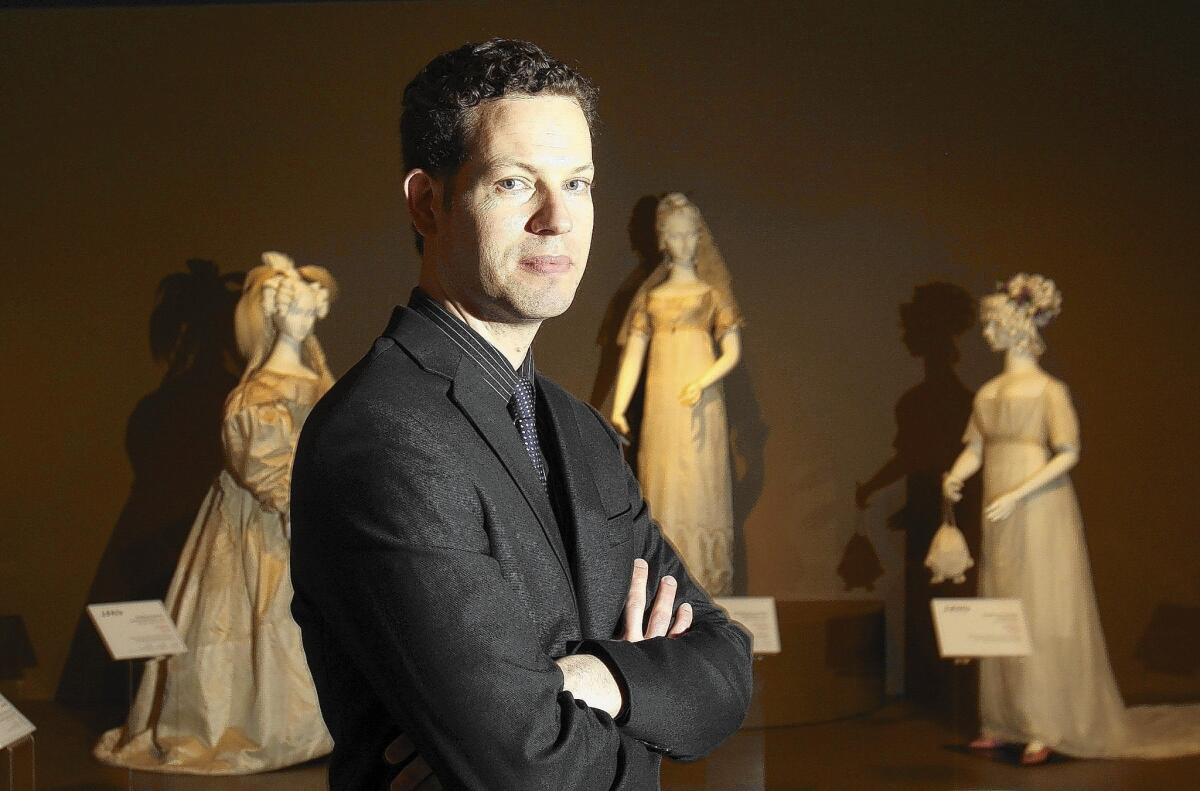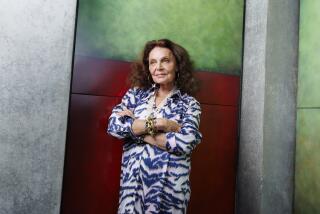For San Francisco, a dress becomes a reminder of survival

SAN FRANCISCO — For decades, the pre-dawn commemoration of the San Francisco earthquake of 1906 has featured dwindling survivors lined up on a stage at Lotta’s Fountain, where those displaced by the April 18 temblor and fire once left messages for loved ones.
On the 80th anniversary, more than 300 honorees turned out, among them three of the Downey brothers — Irish one-time pugilists in derby hats — and Cyril Magnin, who survived the disaster as a boy of 6 and came to head a multimillion-dollar chain of upscale women’s clothing stores.
The late Herb Caen in his San Francisco Chronicle column called it “a convocation of ghosts” and worried that there would one day “be no survivors to remind us of the time a blazing city became a shining hour.”
That day has come. This year, the only two known survivors — aged 108 and 112 — have made it clear they’d rather stay home. Lee Houskeeper, the San Francisco publicist who has orchestrated the event for the past quarter of a century, needed another symbol of pride and resilience.
He found it in a dress. A durable survivor, it is a black, two-piece, silk taffeta number with shamrock-patterned netting and beadwork applique, accompanied by a cream-colored wool broadcloth coat.
Thanks to a Los Angeles-based fashion school, a high-end haberdasher and a local history association president who long kept the dress in a suitcase in his basement, Houskeeper’s event will live on with a new focus.
At the annual pre-event luncheon at John’s Grill on Thursday, and the 5:11 a.m. Lotta’s ceremony the following morning, the call will go out to the city’s oldest families to search their attics for more such treasure.
Wilkes Bashford, whose Union Square store supplies former Assembly Speaker and San Francisco Mayor Willie Brown with his famously elegant wardrobe, will make the plea.
The Fashion Institute of Design & Merchandising, which opened its San Francisco campus in 1975, has examined the dress and pledged to open a gallery here for clothing that survived the earthquake, if enough can be authenticated.
With that, the commemoration — attended by hundreds in period dress who come for the camaraderie, the Bloody Marys and even the official messages on earthquake safety — will go on.
“You can see photos of buildings but until you see individuals in the dress of the time, you don’t know what that time looked like,” said Bashford, 80, who opened his store 48 years ago.
The annual remembrance was started in 1919 by the South of Market Boys, a fraternity that combined local charity with the pleasures of drink.
Real estate investor Leo Sapienza, who served as the group’s last president, carried on the tradition with help from his daughter, Taren Sapienza, who took over in 1980 and brought Houskeeper on board in 1989.
During Houskeeper’s years as event organizer, survivors with sharp memories gave way to those with more impressionistic recollections: a mother bending over a shaking crib, a father protecting his son from falling plaster, the Golden Gate Park encampments that became home to so many.
After the centennial — survivor count: 11 — Sapienza bowed out. The following year, hundreds crowded around Lotta’s to cheer the city’s tenacity. When Houskeeper convened a meeting soon after to debate the event’s fate, it was longtime Chronicle reporter Carl Nolte who tipped the balance.
“He said the event had to go on,” Houskeeper recalled, “because San Francisco is the real survivor.”
Bashford picked up the next piece of the puzzle. An old friend of FIDM founder and president Toni Hohberg, Bashford has been an advisor to the San Francisco campus for two decades. When the publicity-shy Hohberg recently asked him to serve on the board, he agreed on the condition that the school toot its own horn a bit louder, he said.
Hohberg admired the earthquake commemoration and wanted to take part. And so began Houskeeper’s garment search.
He turned to Ron Ross, president of the San Francisco History Assn., who had sold his 3,000-piece collection of original earthquake memorabilia, including recorded oral histories with survivors. He had, however, held on to a certain dress. He dug it up along with the 1988 typed donation letter from Elizabeth A. Jacklin, then of Buffalo Grove, Ill.
“My grandparents were anticipating attending the Opera in 1906 when the earthquake and fire changed their plans,” the letter said. “Strangely, my grandmother’s opera coat and black lace gown were among the few things saved when their home was destroyed and they became ‘street’ people.”
Newspaper advertisements indicate the Jacklins owned several stores, selling glassware and china and restaurant supplies, as well as possibly dolls and meats after the city rebuilt.
Elizabeth Jacklin, now of Sarasota, Fla., said her father was 5 years old and home alone with his two older sisters when the quake struck. Family lore has it that her grandparents — John Joseph and Anna Liberty Jacklin — were planning to attend the opera and that the dress survived because her grandmother was probably wearing it.
Jacklin sent Ross an opera ticket along with the dress, but Ross said he lent it out years ago and it was lost.
Questions remain. The quake struck at 5:11 a.m., when Mrs. Jacklin was not likely to be wearing such an ensemble. Ross said the ticket was for the 18th, but Enrico Caruso’s performance of “Carmen” was on April 17 and there was not another scheduled until the 19th.
Last month, Houskeeper arranged for FIDM to assess the garment, and it was shipped to Kevin Jones, the school’s fashion historian and curator in Los Angeles.
His conclusions, which Jones will share at Thursday’s luncheon: The bodice and skirt “is a very nice ensemble of the era … probably either store bought and tailored to the woman, or made by perhaps her local seamstress following the standard fashions of the day.”
It would have been cutting edge in 1905, perfectly acceptable in 1906 and 1907, and possibly seen in 1908 “if it was worn by a frumpy woman.” The coat may or may not have been worn with it.
However, Jones insists: “This is an afternoon dress.... This never would have been worn to the opera.”
The mismatch between lore and corroborating fact is something “as historians we come across often,” he said. “The stories morph.” But the dress nevertheless has a tale to tell.
“The fact that it was in the city during the earthquake is what makes it exciting and historically a significant piece,” he said. “We don’t need to add any of the glitter of Caruso.”
Houskeeper and Bashford know it won’t be easy to document the provenance of garments to come, particularly because so many records were destroyed in the fire.
But the treasures will open a window onto the end of the Gilded Age here, when even those who were not terribly wealthy often changed clothes three times a day.
“Willie still does,” Bashford noted in an aside, “but in those days, everyone did.”
More to Read
Sign up for Essential California
The most important California stories and recommendations in your inbox every morning.
You may occasionally receive promotional content from the Los Angeles Times.











